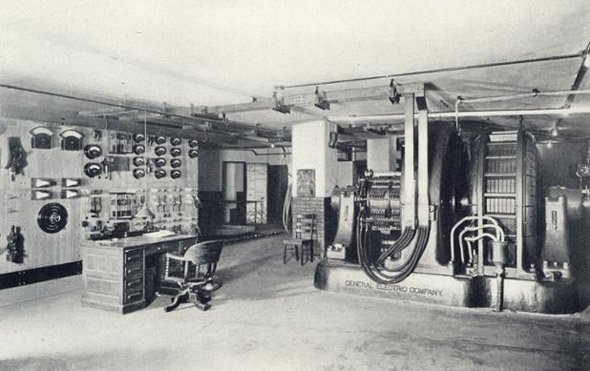Hey, there! Log in / Register
Boston has always had state-of-the-art control centers
By adamg on Mon, 06/22/2015 - 11:17am

The folks at the Boston City Archives wonder if you can figure out what this control center controlled, and when. See it larger.
Neighborhoods:
Topics:
Ad:

Comments
Top secret
back in the day.
Mission control for the
Mission control for the missile silos contained within the Bellevue Hill water tower in West Roxbury
(No subject)
I think that's a dynamo room
Maybe at a Charelstown electric plant? I seem to remember seeing a photo from the late 19th or early 20th century labeled "Dynamo Room, Charlestown Electric Plant" years ago when I was looking through some old photos of Charlestown. I remember thinking that the word dynamo is woefully underused these days.
Detergent
oh were they making detergent?
Some kind of backup or regulation system
The thing on the right looks like a motor-generator pair, wired with 3 phase on the right and DC on the left. The much heavier cabling implies a lower voltage than the cables on the right side. The MBTA happens to use DC on the rails.
Mark is correct. 13.2 kV 25
Mark is correct. 13.2 kV 25 Hz would spin the AC motor on the right would spin the 625 VDC generator on the left. The Roslindale substation (http://www.universalhub.com/2015/things-about-heat-inside-old-roslindale...) use to house this same equipment. I was working over there about 10 years ago to remove the old copper before the T sold the property. The General Electric Company is a British company and should not be mixed up with GE.
The T phased out the roatry converters and went to the modern DC rectifier back in the 70's.
General Electric Company - Schenectady, New York
It is a rotary converter/motor-generator set, but not a particularly huge unit. I'm guessing it more likely powered a trolley line (e.g.: a part of the Green Line) rather than a heavy-rail rapid-transit system. Searching Google shows a number of occasions where such equipment was purchased for the Boston Street Railway from the General Electric Company of Schenectady, New York.
Judging from the buss bars, I think there's a second unit positioned behind this one. It's curious that this machine is installed in a room with such a low ceiling. Power rooms usually had much higher ceilings so that components could be hoisted in and out of position for maintenance and repairs. This looks like it's the basement of a larger building, rather than a stand-alone powerhouse.
This video from New York City has pictures of similar converters; both larger and smaller; accompanied by an audio recording of one starting up:
Note at time 0:37, a quite similar General Electric Company converter.
UHub's server room in the
UHub's server room in the secret Gaffin underground lair taken two days ago.
If only
It's a bit more advanced than what I've got.
Wild Guess
Some sort of T (MTA, in those days, or maybe even BERY) substation?
Suldog
http://jimsuldog.blogspot.com
Roslindale substation?
Roslindale substation?
Just guessing
The Orient Heights substation for the electrification of the Boston, Revere Beach & Lynn Railroad.
It Was One Of My Guesses Too, But ...
... when I looked it up, I found a description and pictures of the Orient Heights substation that ruled it out. In particular, the Orient Heights converters had an elaborate ventilation feature that is missing from the mystery photo.


from: Electric Railway Journal · Vol. 72, No. 23 · December 8, 1928
The Hi-Fi
The Hi-Fi in the Gaffin family rumpus room, circa 1960.
The Answer!
Thanks for playing folks! This is the sub-basement in the 11th station of the Edison Electric Illuminating Company (later known as Boston Edison), This station was at 59 Tremont Street. The image is from the 1905 report of Boston's Wire Department, so it was likely taken in 1904.
The MTA wasn't the only DC power user...
A number of older downtown office buildings had DC wiring (a holdover from the Edison - vs Westinghouse DC vs AC battle of the 1890s, I believe). I know of offices that still had DC power as late as the 1960s. Lights would work fine, but if you wanted to run anything with a motor (e.g., a fan, or an electric typewriter) you needed to buy DC-specific appliances.
Even later than the 60s
Suffolk Superior Court still used DC until it was renovated, what, 10 or 15 years ago?
Is this where Boston Olympics
Is this where Boston Olympics 2024 hatches their crazy ideas?